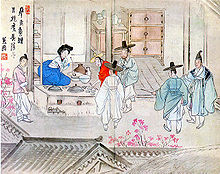

| Jumak | |

InShin Yun-bok's genre painting titled Jusa geobae ("Holding a drinking party"), a jumak is depicted.
| |
| Korean name | |
|---|---|
| Hangul | 주막 |
| Hanja | |
| Revised Romanization | jumak |
| McCune–Reischauer | chumak |
Jumak (Korean: 주막) were traditional Korean tavernsorinns[1] that provided alcohol, food, and lodgings to travellers.[2] They are also called juju (酒肆), juga (酒家), or jupo (酒舖). Jumak were abundant during the Joseon Dynasty and could be found in both rural and urban areas. Jumak came in many varieties with some having stables for livestock, courtyards, and gardens.
One early mention of a jumak was one called Cheongwan (天官) that was owned by a kisaeng (female entertainer).
The Gyeongguk Daejeon (경국대전), devised in 1485 provided rules and regulations concerning the establishments.
An early source could potentially attest to jumak in 1097 during King Sukjong's reign in the Goryeo Dynasty.[3]
According to the text Samguk yusa, a general of Silla, Kim Yu-sin, frequented the establishment when he was young.
The Namhaeng Ilgi (남행일기), or "Diary of a Journey to the South", details jumak encounters by Kim Seong-il.
In the classic novel "The Biography of Hong Gildong" (홍길동전) mentions jumak as places where the hero, Hong Gildong, would hide and gather information during his adventures.
This Korean cuisine–related article is a stub. You can help Wikipedia by expanding it. |